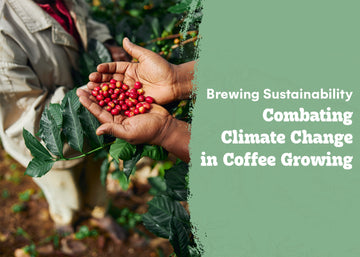Climate Resilience in Coffee Farming: A Sustainable Future
Many consumers across the globe enjoy taking green coffee which is produced from raw seeds of the coffee tree. However, global warming interferes with the delicate environmental requirements required in the manufacturing of this critical commodity. It is well noted that green coffee has been grown in the tropical climatic region of the world; it is sensitive to climates and grows best in areas receiving regular rainfall, well-drained soil, a warm to hot temperature, and at a given altitude. Millions of small holder producers and growers around the globe, maintain the quality as well as quantity of green coffee production and the lives of millions of smallholder farmers who grow it is under threat due to increasing global temperatures, erratic weather patterns, proliferation of pests and diseases.
To overcome these barriers the coffee industry had to adopt “sustainability” as a strategy. Sustainable farming practices include Agroforestry, soil conservation, and development of better climatic conditions. Resilient coffee Cultivars are such examples which aimed to reduce the impacts, which lessens its harm on the environment while enhancing the coping ability of coffee yields. Other technological advancement such as remote sensing and precision agriculture that optimize the use of resources and provide farmers the ability to mitigate for climate shocks are also enabling increase in green coffee production.
Thus, consumers may substantially help in this case by buying certified green coffee products such as the Fair Trade or Rainforest Alliance beans. These certifications ensure that sustainability is achieved throughout the supply chain through promoting environmentally sound practices, fair compensation, and better standards for farmers.
Consumers, academia, governments, and producers must find solutions because the sector exists in a warming world. Green coffee’s future can be secured by focusing on sustainable production practices, and cooperation on the international level to provide fast-growing, sustainable crop supply to the upcoming generations.
Global warming and its impact on Coffee Economy
The climate change has been affecting the coffee production with great severity threatening to cut of one of the world’s most cherished beverages, and at the same time threatening the sources of livelihood for millions of farmers. The favorable climate conditions for growth of coffee is fast being altered by global warming particularly for Arabica that prefers cool climate. In many coffee producing areas, the climate is becoming unfavorable, temperatures vary between 18-24 C but beans degrade and productivity reduces.
The areas that are suitable for coffee production are shifting as the climatic temperatures warms up. Plantation in typical coffee locations are forced to migrate to areas of less temperature and altitude respectively. Such changes often lead to conflict of space use and exercise that prevents check to deforestation aggravating the problem.
This is a significant factor given that climate change is bringing warmer and more humid climatic conditions that are equally sober to pests, and ailments. New challenges have arisen in the form of the coffee berry borer (Hypothenemus Hampei) which has moved on new fronts deepening production declines and the coffee leaf rust (Hemileia Vastatrix) that has swept through Latin American plantations.
Specifically, climatic changes influence the growing and cherishing of coffee plants in ways such as prolonged dry seasons and large, early or late rainfall affect growth of coffee plants. This inconsistency thus poses a great threat to the entire coffee value chain given that both the quantity and quality of produced coffee is affected.
Coffee Production, Its Impact and Contributions Across the Globe
Global Coffee Production: Coffee is the second most traded commodity globally, with more than 10 million tonnes produced annually. These two main varieties are Robusta (Coffea Canephora) and Arabica (Coffea Arabica) accounting for almost all the coffee produced in the world.
Economic Significance: The coffee value chain supports 125 million people across the chain and 25 million small-holder farmers around the world.
Climate Sensitivity: According to the research, it could be an indication that by 2050, climate change might bring down the area amenable for coffee production to 50%.
Global Consumption: Nonetheless, production challenges in world drinking coffee exceeded 175.1 million 60-kg bags in 2023, to show a healthy and growing population.
Impacts by Country
Brazil itself accounts for 40% world production and is mostly Arabica coffee, making it the largest producer of coffee in the world.
- Impact: In some bad years Arabica yield was down by 15-20% as a result of frosts and very severe droughts (exemplified by 2021).
- Innovations: In order to minimize the effects of unstable climate patterns, irrigation and shade grown practices are increasingly being implemented.
Vietnam is the leading producer of robusta coffee in the world and grows more than 1.8 million tonnes per year.
- Impact: Vietnam’s coffee hub that is the Mekong Delta is therefore at risk due to increasing temperatures and lack of water.
- Adaptation: They are currently changing to drought resistant coffee varieties and investing on drip irrigation systems.
Colombia famous for the cultivation of quality Arabica beans that make up only 10 percent of the global market share.
- Impact: Due to this unpredictability in rainfall, diseases including coffee leaf rust (Hemileia Vastatrix) have become prevalent, and blooming reduced.
- Adaptation: Thus, further resilience is being built by creating new rust-resistant coffee varieties, plus more cooperatives are being established.
Ethiopia where coffee was first discovered grows unique Arabica types that are vital to world coffee gentics and gene pool.
- Impact: This study reveals that future climate suitability for coffee production in Ethiopia can range from 39% to 59%, by 2100.
- Reaction: Efforts towards the promotion for agroforests and conservation of wild coffee types.
Indonesia is recognized as the producer of both Arabica and Robusta but with Robusta as the leading product.
- Impact: Places such as Sumatra where coffee is grown is at risk due to deforestation and elevated levels of water.
- Solutions: Efforts have been made in encouraging proper use of inputs in farming, and afforestation.
Extra Climate Information
Temperature Thresholds: Robusta coffee is quite resistant to heat and could grow well at temperatures up to 30oC (86oF) though it requires more water than the Arabica which is sensitive to temperatures over 240C (750F).
Rainfall: The annual rainfall between 1,200 – 2,000 is considered ideal for coffee farming, but due to climate change, the rain patterns are characterized by protracted dry seasons and intense early rains.
Carbon Footprint: This important sector, with the overall tendency toward carbon-neutral growing techniques is estimated to produce as much as 60.6 million tonnes of CO2 annually.
Forecasts and Difficulties
cultivation Declines: On an international level it is expected that the area of land that will be available for coffee production may reduce by as much as 50 percent before the year 2050.
Economic Loss: Special interest countries that rely heavily on coffee exports will be facing losses in billions of dollars, a situation likely to worsen inequality and poverty in those countries.
Techniques of sustainable agriculture
Agroforestry
- Shapes an agricultural bio-diverse system by arranging the plants in a way that comprises coffee plants with trees and bushes.
- Prevents water evaporation and also protects coffee plants from direct sunlight by acting as a canopy.
- Leads to improvement in its internal ecosystem’s biological diversity since it provides habitats to useful insects and birds for pest control.
- It also helps the farm to mitigate climate change by promoting the process of carbon storage in the farm’s environment.
Organic Agriculture
- Reduces or totally eradicates the incorporation of artificial pesticides, herbicides, and fertilizers.
- Promotes the use of bio fertilizers, green manure and organic compost, their usage enhances soil fertility and reduce pollution of the environment.
- Better soil and more enduring coffee plants suggested by the enhancement of the value of the ecological niche.
Methods for Conserving Soil
- Employing the methods of cover crops, mulching, and terracing with an effort to reduce soil erosion especially in the slopes.
- Improves water holding capacity of soil thus helps coffee plants to survive periods of drought.
- Improves microbial populations and porosity of the ground and hence, aids the health of plants and their production rates.
Climate Change Tolerant Coffee Types
Drought Resistant Varieties
- Concentrates on developing new sorts of coffee with excellent yields and quality but require small water.
- These types are useful in places where there is a long-dry season or occasional scarcity of water.
Varieties Resistant to Pests
- Proposes new coffee types which are resistant to diseases, such as coffee leaf rust, and insects, the coffee berry borer.
- Reduces further impacts to the environment and costs of farming since it incorporates fewer chemical pesticides.
Species that are hybrid
- Combines features of Robusta and Arabica species to develop certain interspecies that may retain the flavor quality at unfavorable conditions.
- Therefore, the objective of current research is to enhance vulnerability to cope with climate stress, yield, and adaptation.
Innovations in Technology
Accurate Farming
- Employs GPS, IoT devices and combines data on crop status, state of the soil and resources consumption.
- Saves time, water and money by helping farmers to water and fertilize the crops where they are needed.
- It is used in the best allocation of plantation and harvesting times to enhance production.
AI and Remote Sensing
- Observes signs of weather stress or diseases or insects which are likely to affect coffee plants through drones and satellite photos.
- Farmers can go an extra mile and try to protect their produce by incorporating climate change AI models to predict adverse impacts.
- Enables the farmers to adapt to changing conditions since it provides information on long run trends.
Green Solutions
Irrigation
- It also recommends strict reduction of water wastage through methods of water harvesting such as rain water harvesting and Drip irrigation.
- Encourages use of sensors to monitor the state of moisture and watering the crops only when necessary.
- Reduces injury to the environment while ensuring that crops get adequate water when there is little rain.
The Value of Certifications
- There are also main commitments to sustainable agriculture profiles such as Rainforest Alliance, Fair Trade, and Organic Coffee.
- Promote community welfare, safety and wages for appropriate remuneration in the production factors of coffee.
Promoting Customer Assistance
- Informing the audience about the benefits of sustainably produced coffee from the perspective of environment and the community.
- The process of customer education and labelling of certified products so that customers will pay more attention to certified coffee goods.
A survey on Open-ness in the Supply Chain for Coffee
- Implementing traceability technology that allows customers to trace their coffee right from the farms to their cups.
- Ensures that accountability for stewardship of sustainable behavior throughout the value chain and builds confidence.
International and Regional Projects
Cooperation Attempts
- Coffee farms, non-governmental organizations, and government fund research and sustainability activities.
- Combined resources and information help to foster innovation and ease the burden of work from specific farmers.
Effective Case Studies
Ethiopia: Wild coffee types are being protected through sustainable tree growing practices.
Colombia: Outgrowing schemes promote the use of rust resistant coffee varieties.
Vietnam: Sustainable methods in water support irrigation in areas that grow robusta.
Investments and Policies
- The promotions for a certain type of climate resilient coffee, for eco-friendly equipment for growing coffee.
- Policies for eliminating deforestation and stimulating the protection of land in the coffee production areas.
Prospects for the Future
Solutions for Scaling
- The continuation of pilot projects to more regions so as to affect more people in the community.
- Being able to teach farmers about sustainable farming techniques that can be learned through printable lessons.
Demand and Sustainability
- Protecting the environment and at the same time ensure that it meets the increasing global consumption of coffee.
- Increasing consumer awareness in order to synchronize environmental actions with demand.
Long-Term Plans
- Long term funding for researches to develop resistant coffee varieties to diseases.
- Strengthening its research partnerships with its counterparts in other countries in order to come up with a strategic plan towards sustainable development.
- Mitigating climate change risks in the coffee industry and supporting the quality of life for growers.
Sustainability in the Light of the Economy and Society
- Greatly supporting fair trade methods, resources and information to the small-holder farmers.
- Achieving financial support to integrate sustainable activities.
- Building up of cooperative organizations for reinforcement of community intervention.
Conclusion (Greenbrrew is the name of the initiative to combat climate change and promote moral behavior)
Farmers, academics, governments, businesses, and consumers will have to come into a partnership in the future as the coffee industry will grow. Due to promoting and consuming certified and sustainable coffee products, the industry is challenged to adopt environmental friendly ways and practices and to provide fair labor conditions. These initiatives help make coffee more resistant by linking a lengthy past of this classic beverage with a sustainable future for future generations.
Despite increasing challenges, one of the most popular drinks globally can persist as the hallmark of world culture due to new innovation, added sustainability, and consistency of quality that is revolutionizing the coffee industry. The fight against climate change and the vindication of the good is proved through production of green coffee or marketing of environmental friendly blends such as Greenbrrew.
Companies as Greenbrrew helps to strenghten these efforts by offering accurately crafted blends that meet customer palates’ and environmental concerns’ requirements. Greenbrrew is a perfect example, where companies may benefit from focusing on the sustainability since they encourage ethical sourcing, use unique tastes, and have global reach.
Although Greenbrrew has focused mainly on the Indian market it is gradually being recognized widely in the Indian coffee market. Consumers may easily buy their preferred coffee blends on their website, https://greenbrrew.com is a portal that offers blotter strains anywhere within the India and have them shipped to your door. That is why coffee lovers can quickly find Greenbrew’s products, as the company’s assortment is available on such platforms as Amazon, Flipkart, Nykaa, Worthy Cart, and Walmart.



